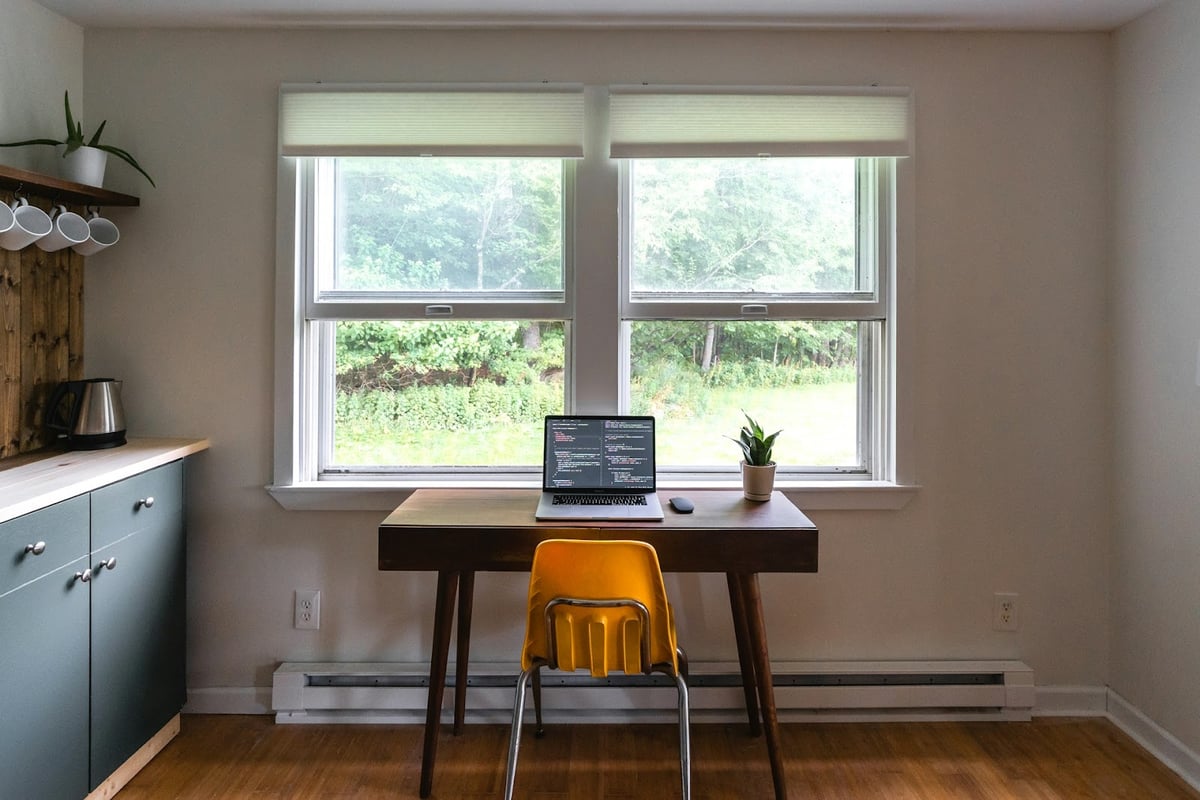Remember commuting? That daily ritual of human sardine cans and traffic standstills while mentally tallying the avalanche of work waiting at your desk?
Yeah, nobody misses that nightmare.
The traditional office isn't just changing—it's being completely reinvented. Working from home has graduated from occasional luxury to everyday reality. Stanford research shows that 42% of the U.S. labor force now works from home full-time.
That's millions mastering the art of looking professional on Zoom while rocking pajama bottoms.
But remote work demands more than just decent WiFi and a laptop. It requires creating a space where you can actually produce without the soul-crushing elements of office life.
The freedom sounds amazing until you're battling the siren call of your refrigerator, the neighbor who apparently moonlights as a heavy metal drummer, and the dangerous evaporation of boundaries between work and everything else.
In this guide, I'll hand you the exact strategies and tools to dominate your remote workspace—without morphing into a cave-dwelling hermit or burning yourself into a productivity-obsessed husk.
Let's fix this.

Let's start with your basecamp - your workspace.
The ideal workspace should inspire productivity and minimize distractions—which means no, your bed or sofa is not an office (no matter how comfy those pillows are).
Creating a dedicated workspace signals your brain that it's time to work. It also signals to your family or roommates that when you're in this space, you're not available for discussions about whose turn it is to empty the dishwasher.
Here's what to prioritize:
Personalize your space with plants or artwork, but keep it functional and distraction-free.
As organizational guru Marie Kondo would say, your workspace should spark productivity—not anxiety or the urge to nap.

When your commute is just the fifteen steps from your bedroom to your desk, creating a morning routine becomes crucial.
Without the standard office structure, you need to create your own.
A routine is crucial because it takes a lot of thinking in the form of micro-decisions out of your day. Instead of deciding every single day what you'll do and how you'll do it, you can invest that energy in just getting on with it.
This provides structure, maintains your energy, and helps you stay focused.
Set clear start and end times for your workday. Just because you can work at any hour doesn't mean you should. Your brain needs to know when it's work time and when it's personal time.
Create a morning ritual that mentally prepares you for work:
Schedule regular breaks throughout your day.
The Pomodoro Technique (25 minutes of focused work followed by a 5-minute break) works wonders for many remote workers. And yes, scrolling social media counts as a break only if you've deliberately scheduled it as one.
Don't underestimate the power of consistency.
Your body and brain crave routine, even if your rebellious spirit insists otherwise. By following similar patterns each day, you'll naturally fall into a productive rhythm.
Time management is crucial for maximizing productivity and avoiding burnout—especially when Netflix is just a click away, and no one will know if you watch "just one episode" in the middle of the workday. (Except you. You'll know.)
Experiment with these proven techniques:
Combat the digital distractions that are the kryptonite of home workers:
Use project management tools like Asana, Trello, or Monday.com to track progress and collaborate with team members. These platforms create visibility and accountability when you can't physically see your colleagues.
Set realistic goals and celebrate your achievements to stay motivated. Working from home means you have to be your own cheerleader sometimes. Finished a big project?
Take yourself out for coffee, or do a victory dance around your living room. No one's watching—that's the beauty of remote work!

When you can't tap a colleague on the shoulder or read the room during a meeting, effective communication becomes both more challenging and more essential.
Effective communication is the glue that holds remote teams together. Without those spontaneous office interactions, you need to be intentional about how and when you communicate.
Use video conferencing for meetings whenever possible. Seeing faces builds connection and reduces misunderstandings. Just remember to occasionally look at the camera, not just at yourself. (We all check our appearance, but try limiting self-gazing.)
For quick updates and informal chats, instant messaging tools like Slack or Microsoft Teams create that "digital water cooler" effect. Create channels for both work discussions and social chit chat to maintain team culture.
Schedule regular check-ins with your team. These touchpoints provide structure and ensure everyone stays aligned. They also prevent the "out of sight, out of mind" syndrome with remote workers.
Be proactive in your communication:
Remember that written communication lacks tone cues. That message you think sounds perfectly professional might come across as curt or angry. When in doubt, add an emoji or simply pick up the phone. And never send important emails when you're tired or emotional—the "draft" folder exists for a reason.
Working from home can blur the lines between work and personal life faster than a toddler with finger paints on a white wall.
When your office is also your living space, boundaries become essential.
Set clear boundaries between work and personal time. This means actually ending your workday—not just shifting from your desk to your couch with your laptop.
Implement a shutdown ritual that signals the end of your workday, like closing your laptop, changing your clothes, or taking a walk.
Physical boundaries help too:
Take regular breaks throughout your day. The human brain isn't designed for eight straight hours of focus. Schedule breaks for movement, fresh air, and mental resets. Your productivity will actually improve.
Disconnect from work at the end of the day. This means turning off email notifications and work chat alerts. If you absolutely must check in after hours, set specific times rather than staying perpetually available.
Schedule time for hobbies, exercise, and relaxation. Block these activities in your calendar just as you would a work meeting—they're equally important. The tendency to work "just a little longer" is strong when home, but resist it.
Remember: Working longer hours doesn't necessarily mean more productivity. Quality often trumps quantity, and burnout is a real threat when work is always accessible. As the saying goes, "Work expands to fill the time available," so set limits for that time.

"I've been talking to my houseplants" might sound like a joke, but after weeks of limited human interaction, those leafy friends start looking like legitimate conversation partners.
Working from home can sometimes lead to feelings of isolation, even for introverts.
The casual social interactions of office life—chatting by the coffee machine, lunch with colleagues, even just seeing other humans regularly—fulfill an important psychological need. When working remotely, you need to intentionally create opportunities for connection.
Schedule virtual social events with colleagues, like coffee chats, virtual lunches, or after-work gatherings. These don't have to be long or elaborate—even 15 minutes of non-work conversation can boost morale and connection.
Join online communities related to your profession or interests. Forums, Slack groups, or social media communities can provide both professional networking and social interaction. They're also great sources of advice and support from others in similar situations.
Maintain regular contact with friends and family. When work and home become the same place, it's easy to become absorbed in work and neglect personal relationships. Schedule calls or meet-ups just as you would work meetings.
Consider working occasionally from a coffee shop, co-working space, or library if your job allows it. The change of scenery and presence of other people (even strangers) can refresh your perspective and energy.
Remember that quality of interaction often matters more than quantity. A meaningful 30-minute conversation can do more for your sense of connection than hours of social media scrolling.
Working from home isn't just a different location—it's a different mindset. The freedom is intoxicating, but like any powerful tool, it requires skill to master.
Your remote work success hinges on five critical elements:
Don't try to revolutionize everything overnight. Pick ONE strategy from this guide and implement it this week. Small, consistent improvements compound faster than radical overhauls that fizzle out by Thursday.
Remember: You're pioneering a work style once reserved for the privileged few. There will be awkward video calls, pajama-clad emergencies, and days when productivity feels as elusive as matching socks. That's normal. Keep experimenting until you find your unique remote work rhythm.
Feeling isolated in your remote work journey? Connect with experienced remote professionals at MentorCruise who've already navigated the challenges you're facing.
Their personalized guidance can help you build a remote work lifestyle that maximizes both your productivity and well-being.
Now, excuse me while I finally change out of these pajamas. It's definitely time for lunch... or is it dinner? Working from home, the days blur together—but at least I'm not stuck in traffic.
Find out if MentorCruise is a good fit for you – fast, free, and no pressure.
Tell us about your goals
See how mentorship compares to other options
Preview your first month
